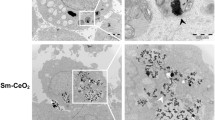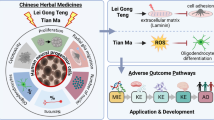Abstract
Triclosan (TCS) is ubiquitous in a wide range of personal care and consumer products, and it is acute/chronic exposure may result in several nervous system disorders. Previous studies demonstrated TCS-induced abnormal expression of miRNAs, but no investigations focused on upstream changes of miRNAs and associated molecular mechanisms. Herein, phenotype observation and behavioral analysis confirmed that TCS exposure (0, 62.5, 125, 250 μg/L) led to developmental neurotoxicity in zebrafish larvae, especially for oligodendrocyte precursor cells (OPCs). High-throughput sequencing demonstrated the critical role of miR-219 in the differentiation of OPCs. Larvae with miR-219 depletion showed the same phenotype caused by TCS. Functional tests with miR-219 knock-down and over-expression showed that miR-219 promoted differentiation of OPCs by acting on myelination inhibitors. The miR-219 also protected against TCS-induced inhibition of cell differentiation. Several epigenetic features were identified to reveal potential upstream regulatory mechanisms of miR-219. In particular, five CpG islands hyper-methylated with increasing TCS concentrations in the promoter region of miR-219. TCS inhibited OPC differentiation by influencing epigenetic effects on miR-219-related pathways, contributing to severe neurotoxicity. These findings enhance our understanding of epigenetic mechanisms affecting demyelination diseases due to TCS exposure, and also provide theoretical guidance for early intervention and gene therapy of environmentally induced diseases.






Similar content being viewed by others
References
Andrews S (2010) FastQC: a quality control tool for high throughput sequence data. Available online at: http://www.bioinformatics.babraham.ac.uk/projects/fastqc
Bilotta J, Saszik S, DeLorenzo AS, Hardesty HR (1999) Establishing and maintaining a low-cost zebrafish breeding and behavioral research facility. Behav Res Methods Instrum Comput 31(1):178–184
Bolger AM, Lohse M, Usadel B (2014) Trimmomatic: a flexible trimmer for Illumina sequence data. Bioinformatics 30(15):2114–2120
Budde H, Schmitt S, Fitzner D, Opitz L, Salinas-Riester G, Simons M (2010) Control of oligodendroglial cell number by the miR-17-92 cluster. Development 137(13):2127–2132
Chen B, Khodadoust MS, Liu CL, Newman AM, Alizadeh AA (2018) Profiling tumor infiltrating immune cells with CIBERSORT. Methods Mol Biol (Clifton, N.J.) 1711:243–259. https://doi.org/10.1007/978-1-4939-7493-1_12
Chhabra R (2015) miRNA and methylation: a multifaceted liaison. ChemBioChem 16(2):195–203
Chiu CN, Prober DA (2013) Regulation of zebrafish sleep and arousal states: current and prospective approaches. Front Neural Circuit 7:58
Dann AB, Hontela A (2011) Triclosan: environmental exposure, toxicity and mechanisms of action. J Appl Toxicol 31(4):285–311
Dugas JC, Tai YC, Speed TP, Ngai J, Barres BA (2006) Functional genomic analysis of oligodendrocyte differentiation. J Neurosci 26(43):10967–10983
Dugas JC, Cuellar TL, Scholze A et al (2010) Dicer1 and miR-219 are required for normal oligodendrocyte differentiation and myelination. Neuron 65(5):597–611
Fünfschilling U, Supplie LM, Mahad D et al (2012) Glycolytic oligodendrocytes maintain myelin and long-term axonal integrity. Nature 485(7399):517–521
Glasgow SM, Zhu W, Stolt CC et al (2014) Mutual antagonism between Sox10 and NFIA regulates diversification of glial lineages and glioma subtypes. Nat Neurosci 17(10):1322–1329
Gong T, Szustakowski JD (2013) DeconRNASeq: a statistical framework for deconvolution of heterogeneous tissue samples based on mRNA-Seq data. Bioinformatics 29(8):1083–1085
Han J, Won E-J, Hwang U-K, Kim I-C, Yim JH, Lee J-S (2016) Triclosan (TCS) and Triclocarban (TCC) cause lifespan reduction and reproductive impairment through oxidative stress-mediated expression of the defensome in the monogonont rotifer (Brachionus koreanus). Comp Biochem Phys C 185:131–137
Irons T, MacPhail R, Hunter D, Padilla S (2010) Acute neuroactive drug exposures alter locomotor activity in larval zebrafish. Neurotoxicol Teratol 32(1):84–90
Ishibashi H, Matsumura N, Hirano M et al (2004) Effects of triclosan on the early life stages and reproduction of medaka Oryzias latipes and induction of hepatic vitellogenin. Aquat Toxicol 67(2):167–179
Kim D, Langmead B, Salzberg SL (2015) HISAT: a fast spliced aligner with low memory requirements. Nat Methods 12(4):357–360
Kim J, Oh H, Ryu B et al (2018) Triclosan affects axon formation in the neural development stages of zebrafish embryos (Danio rerio). Environ Pollut 236:304–312
Kogata N, Howard BA (2013) A whole-mount immunofluorescence protocol for three-dimensional imaging of the embryonic mammary primordium. J Mammary Gland Biol 18(2):227–231
Krol J, Loedige I, Filipowicz W (2010) The widespread regulation of microRNA biogenesis, function and decay. Nat Rev Genet 11(9):597–610
Kulkarni P, Yellanki S, Medishetti R, Sriram D, Saxena U, Yogeeswari P (2017) Novel Zebrafish EAE model: a quick in vivo screen for multiple sclerosis. Mult Scler Relat Dis 11:32–39
Kumar KS, Priya SM, Peck AM, Sajwan KS (2010) Mass loadings of triclosan and triclocarbon from four wastewater treatment plants to three rivers and landfill in Savannah, Georgia, USA. Arch Environ Contam Toxicol 58(2):275–285
Li X, Newbern JM, Wu Y et al (2012) MEK is a key regulator of gliogenesis in the developing brain. Neuron 75(6):1035–1050
Li B, Liu JS, Liu XS (2017) Revisit linear regression-based deconvolution methods for tumor gene expression data. Genome Biol 18(1):127
Liao Y, Smyth GK, Shi W (2013) featureCounts: an efficient general purpose program for assigning sequence reads to genomic features. Bioinformatics 30(7):923–930
Liu J, Xiang C, Huang W et al (2019) Neurotoxicological effects induced by up-regulation of miR-137 following triclosan exposure to zebrafish (Danio rerio). Aquat Toxicol 206:176–185
Ma Y, Zang L, Wang D et al (2019) Effects of miR-181a-5p abnormal expression on zebrafish (Danio rerio) vascular development following triclosan exposure. Chemosphere 223:523–535
MacPhail R, Brooks J, Hunter D, Padnos B, Irons T, Padilla S (2009) Locomotion in larval zebrafish: influence of time of day, lighting and ethanol. Neurotoxicology 30(1):52–58
Mahmood T, Yang PC (2012) Western blot: technique, theory, and trouble shooting. N Am J Med Sci 4(9):429–434
Meador JP, Yeh A, Gallagher EP (2018) Adverse metabolic effects in fish exposed to contaminants of emerging concern in the field and laboratory. Environ Pollut 236:850–861
Oliveira R, Domingues I, Grisolia CK, Soares AM (2009) Effects of triclosan on zebrafish early-life stages and adults. Environ Sci Pollut Res Int 16(6):679–688
Park BK, Gonzales ELT, Yang SM, Bang M, Choi CS, Shin CY (2016) Effects of triclosan on neural stem cell viability and survival. Biomol Ther 24(1):99–107
Ramírez F, Ryan DP, Grüning B et al (2016) deepTools2: a next generation web server for deep-sequencing data analysis. Nucleic Acids Res 44(W1):W160–W165
Reiss R, Lewis G, Griffin J (2009) An ecological risk assessment for triclosan in the terrestrial environment. Environ Toxicol Chem 28(7):1546–1556
Sadakierska-Chudy A, Filip M (2015) A comprehensive view of the epigenetic landscape. Part II: histone post-translational modification, nucleosome level, and chromatin regulation by ncRNAs. Neurotox Res 27(2):172–197
Saito Y, Saito H, Liang G, Friedman JM (2014) Epigenetic alterations and microRNA misexpression in cancer and autoimmune diseases: a critical review. Clin Rev Allergy Immunol 47(2):128–135
Saley A, Hess M, Miller K, Howard D, King-Heiden TC (2016) Cardiac toxicity of triclosan in developing zebrafish. Zebrafish 13(5):399–404
Saverino C, Gerlai R (2008) The social zebrafish: behavioral responses to conspecific, heterospecific, and computer animated fish. Behav Brain Res 191(1):77–87
Schebesta M, Serluca FC (2009) Olig1 expression identifies developing oligodendrocytes in zebrafish and requires hedgehog and notch signaling. Dev Dyn 238(4):887–898
Szychowski KA, Wnuk A, Kajta M, Wójtowicz AK (2016) Triclosan activates aryl hydrocarbon receptor (AhR)-dependent apoptosis and affects Cyp1a1 and Cyp1b1 expression in mouse neocortical neurons. Environ Res 151:106–114
Thorvaldsdóttir H, Robinson JT, Mesirov JP (2013) Integrative genomics viewer (IGV): high-performance genomics data visualization and exploration. Brief Bioinform 14(2):178–192
Vesterlund L, Jiao H, Unneberg P, Hovatta O, Kere J (2011) The zebrafish transcriptome during early development. BMC Dev Biol 11(1):30
Vingskes AK, Spann N (2018) The toxicity of a mixture of two antiseptics, triclosan and triclocarban, on reproduction and growth of the nematode Caenorhabditis elegans. Ecotoxicology 27(4):420–429
von Bartheld CS, Bahney J, Herculano-Houzel S (2016) The search for true numbers of neurons and glial cells in the human brain: a review of 150 years of cell counting. J Comp Neurol 524(18):3865–3895
Vrba L, Muñoz-Rodríguez JL, Stampfer MR, Futscher BW (2013) miRNA gene promoters are frequent targets of aberrant DNA methylation in human breast cancer. PLoS One 8(1):e54398
Wang CF, Tian Y (2015) Reproductive endocrine-disrupting effects of triclosan: population exposure, present evidence and potential mechanisms. Environ Pollut 206:195–201
Weber B, Stresemann C, Brueckner B, Lyko F (2007) Methylation of human microRNA genes in normal and neoplastic cells. Cell Cycle 6(9):1001–1005
Wienholds E, Kloosterman WP, Miska E et al (2005) MicroRNA expression in zebrafish embryonic development. Science 309(5732):310–311
Yin W, Hu B (2014) Knockdown of Lingo1b protein promotes myelination and oligodendrocyte differentiation in zebrafish. Exp Neurol 251:72–83
Zang L, Ma Y, Huang W et al (2019) Dietary Lactobacillus plantarum ST-III alleviates the toxic effects of triclosan on zebrafish (Danio rerio) via gut microbiota modulation. Fish Shellfish Immunol 84:1157–1169
Zhang C, Liu F (2013) A brief protocol for high-resolution whole mount in situ hybridization in zebrafish. Yi chuan 35(4):522–528
Zhang Y, Chen K, Sloan SA et al (2014) An RNA-sequencing transcriptome and splicing database of glia, neurons, and vascular cells of the cerebral cortex. J Neurosci 34(36):11929–11947
Zhao X, He X, Han X et al (2010) MicroRNA-mediated control of oligodendrocyte differentiation. Neuron 65(5):612–626
Acknowledgements
This work was jointly supported by the National Natural Science Foundation of China (31770552), Natural Science Foundation of Zhejiang and Jiangsu Province (LY20C03005 and BK20191455), Xinmiao Talent Project of Zhejiang Province (2019R413085), and Entrepreneurship and Innovation Program of Jiangsu Province (2017-2018).
Author information
Authors and Affiliations
Corresponding authors
Ethics declarations
Conflict of interest
The authors declare that they have no competing interests.
Additional information
Publisher's Note
Springer Nature remains neutral with regard to jurisdictional claims in published maps and institutional affiliations.
Electronic supplementary material
Below is the link to the electronic supplementary material.
Rights and permissions
About this article
Cite this article
Ling, Y., Sun, L., Wang, D. et al. Triclosan induces zebrafish neurotoxicity by abnormal expression of miR-219 targeting oligodendrocyte differentiation of central nervous system. Arch Toxicol 94, 857–871 (2020). https://doi.org/10.1007/s00204-020-02661-1
Received:
Accepted:
Published:
Issue Date:
DOI: https://doi.org/10.1007/s00204-020-02661-1




